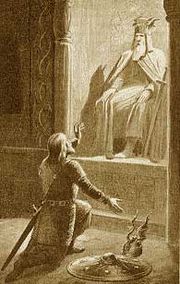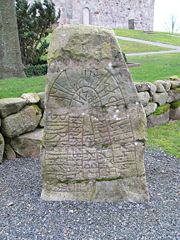
Eric VI of Sweden
Encyclopedia


Mälaren
Lake Mälaren is the third-largest lake in Sweden, after Lakes Vänern and Vättern. Its area is 1,140 km² and its greatest depth is 64 m. Mälaren spans 120 kilometers from east to west...
and by the Götar around Lake Vättern
Vättern
Vättern is the second largest lake in Sweden, after Lake Vänern and the sixth largest lake in Europe. It is a long, finger-shaped body of fresh water in south central Sweden to the southeast of Vänern pointing at the tip of Scandinavia....
.
Sometimes Eric the Victorious is referred to as either King Eric V or VI, modern inventions based on counting backwards from Eric XIV
Eric XIV of Sweden
-Family and descendants:Eric XIV had several relationships before his marriage. With Agda Persdotter he had four daughters:#Margareta Eriksdotter , married 1592 to Olov Simonsson, vicar of Horn....
(1560–68), who adopted his numeral according to a fictitious history of Sweden. Whether or not there were any Swedish monarchs named Eric before Eric the Victorious is disputed, with some historians claiming that there were several earlier Erics, and others questioning the reliability of the primary sources used and the existence of these earlier monarchs. The list of monarchs after him is also complicated (see Eric Stenkilsson and Eric the Pagan
Eric the Pagan
Eric was a contender for the Swedish kingship in 1066–67. After the death of King Stenkil, he made war on Eric Stenkilsson for the Swedish throne. Both died in the war. The two rivalling Eriks are only known by their first name and from one source...
, as well as Erik Årsäll), which makes the assignment of any numeral problematic.
His original territory lay in Uppland
Uppland
Uppland is a historical province or landskap on the eastern coast of Sweden, just north of Stockholm, the capital. It borders Södermanland, Västmanland and Gästrikland. It is also bounded by lake Mälaren and the Baltic sea...
and neighbouring provinces. He acquired the name "victorious" as a result of his defeating an invasion from the south in the Battle of Fýrisvellir close to Uppsala. Reports that Eric's brother Olof
Olof (II) Björnsson
Olof Björnsson , was a semi-legendary Swedish king, who according to Hervarar saga and the Styrbjarnar þáttr Svíakappa ruled together with his brother Eric the Victorious. He was the father of Styrbjörn Starke and Gyrid by his queen, Ingeborg Thrandsdotter, and he died of poison during a meal...
was the father of his opponent in that battle, Styrbjörn the Strong
Styrbjörn the Strong
Styrbjörn the Strong was, according to late Norse sagas, the son of the Swedish king Olof, and the nephew of Olof's co-ruler and successor Eric the Victorious, who defeated and killed Styrbjörn at the Battle of Fyrisvellir...
, belong to the realm of myth.
The extent of his kingdom is unknown. In addition to the Swedish heartland round lake Mälaren
Mälaren
Lake Mälaren is the third-largest lake in Sweden, after Lakes Vänern and Vättern. Its area is 1,140 km² and its greatest depth is 64 m. Mälaren spans 120 kilometers from east to west...
it may have extended down the Baltic Sea
Baltic Sea
The Baltic Sea is a brackish mediterranean sea located in Northern Europe, from 53°N to 66°N latitude and from 20°E to 26°E longitude. It is bounded by the Scandinavian Peninsula, the mainland of Europe, and the Danish islands. It drains into the Kattegat by way of the Øresund, the Great Belt and...
coast as far south as Blekinge
Blekinge
' is one of the traditional provinces of Sweden , situated in the south of the country. It borders Småland, Scania and the Baltic Sea.The name "Blekinge" comes from the adjective bleke, which corresponds to the nautical term for "dead calm"....
. According to Adam of Bremen
Adam of Bremen
Adam of Bremen was a German medieval chronicler. He lived and worked in the second half of the eleventh century. He is most famous for his chronicle Gesta Hammaburgensis Ecclesiae Pontificum .-Background:Little is known of his life other than hints from his own chronicles...
, he also briefly controlled Denmark after having defeated Sweyn Forkbeard.
According to the Flateyjarbok
Flateyjarbók
The Flatey Book, is an important medieval Icelandic manuscript. It is also known as GkS 1005 fol. and by the Latin name Codex Flateyensis.- Description :...
, his success was because he allied with the free farmers against the aristocratic jarl class, and it is obvious from archeological findings that the influence of the latter diminished during the last part of the tenth century. He was also, probably, the introducer of the famous medieval Scandinavian system of universal conscription known as the ledung in the provinces around Mälaren.
In all probability he founded the town of Sigtuna
Sigtuna
Sigtuna is a locality situated in Sigtuna Municipality, Stockholm County, Sweden with 18 inhabitants in 2005. It is the namesake of the municipality even though the seat is in Märsta....
, which still exists and where the first Swedish coins were stamped for his son and successor Olof Skötkonung.
Sagas
Eric the Victorious appears in a number of Norse sagaNorse saga
The sagas are stories about ancient Scandinavian and Germanic history, about early Viking voyages, the battles that took place during the voyages, about migration to Iceland and of feuds between Icelandic families...
s, historical stories which nonetheless had a heathy dose of fiction. In various stories, he is described as the son of Björn Eriksson
Björn (III) Eriksson
Björn was the father of Olof Björnsson and Eric the Victorious, and he was the grandfather of Styrbjörn the Strong, according to the Hervarar saga and Harald Fairhair's saga...
, and as having ruled together with his brother Olof. It was claimed that he married the infamous (and likely fictional) Sigrid the Haughty
Sigrid the Haughty
Sigrid the Haughty, also known as Sigríð Storråda, is a queen appearing in Norse sagas as wife, first of Eric the Victorious of Sweden, then Sweyn Forkbeard of Denmark. While given the Nordic ancestry in sagas, she has been hypothesized to be identical to historically attested Polish or Pomeranian...
, daughter of the legendary Viking Skagul Toste
Skagul Toste
Skoglar Toste or Skoglar Tosti was a chieftain from the Swedish province of West Götaland. According to Snorri Sturluson, he was the father of Sigrid the Haughty. For some time he gave refuge to Harald Grenske, who later came back to woo Sigrid, only to be killed by her for his persistence...
, and later divorced her and gave her Götaland
Götaland
Götaland , Gothia, Gothland, Gothenland, Gautland or Geatland is one of three lands of Sweden and comprises provinces...
as a fief. According to Eymund's saga
Eymund's saga
Eymundar þáttr hrings is a short Norse saga, which is preserved in two versions. One of them appears as Eymundar þáttr hrings in the Flatey Book and the other one is an introductory chapter in Yngvars saga víðförla...
he took a new queen, Auð
Aud Haakonsdottir of Lade
Aud Haakonsdottir of Lade, also called Öda Haakonsdottir of Lade , was a legendary Swedish Viking age queen consort, according to the sagas the last spouse of King Eric the Victorious of Sweden....
, the daughter of Haakon Sigurdsson
Haakon Sigurdsson
Haakon Sigurdarsson was the de facto ruler of Norway from about 975 to 995.-Background:Haakon was the son of Sigurd Haakonsson, Jarl of Lade and ruler of Trøndelag and Hålogaland. His mother was Bergljot Toresdatter, daughter of Tore Ragnvaldsson, Earl of Møre...
, the ruler of Norway
Norway
Norway , officially the Kingdom of Norway, is a Nordic unitary constitutional monarchy whose territory comprises the western portion of the Scandinavian Peninsula, Jan Mayen, and the Arctic archipelago of Svalbard and Bouvet Island. Norway has a total area of and a population of about 4.9 million...
.
Before this happened, his brother Olof died, and a new co-ruler had to be appointed, but the Swedes are said to have refused to accept his rowdy nephew Styrbjörn the Strong as his co-ruler. Styrbjörn was given 60 longships by Eric and sailed away to live as a Viking. He would become the ruler of Jomsborg
Jomsborg
Jomsborg was a semi-legendary Viking stronghold at the southern coast of the Baltic Sea , that existed between the 960s and 1043. Its inhabitants are known as Jomsvikings. Jomsborg's exact location has not yet been established, though it is maintained that Jomsborg was somewhere on the islands of...
and an ally and brother-in-law of the Danish king Harold Bluetooth. Styrbjörn returned to Sweden with an army, although Harald and the Danish
Denmark
Denmark is a Scandinavian country in Northern Europe. The countries of Denmark and Greenland, as well as the Faroe Islands, constitute the Kingdom of Denmark . It is the southernmost of the Nordic countries, southwest of Sweden and south of Norway, and bordered to the south by Germany. Denmark...
troops supposedly turned back. Eric won the Battle of Fýrisvellir at Old Uppsala
Gamla Uppsala
Gamla Uppsala is a parish and a village outside Uppsala in Sweden. It had 16,231 inhabitants in 1991.As early as the 3rd century AD and the 4th century AD and onwards, it was an important religious, economic and political centre...
, according to Styrbjarnar þáttr Svíakappa
Styrbjarnar þáttr Svíakappa
Styrbjarnar þáttr Svíakappa is a short story, a þáttr on the Swedish claimant and Jomsviking Styrbjörn the Strong preserved in the Flatey Book ....
after sacrificing to Odin
Odin
Odin is a major god in Norse mythology and the ruler of Asgard. Homologous with the Anglo-Saxon "Wōden" and the Old High German "Wotan", the name is descended from Proto-Germanic "*Wodanaz" or "*Wōđanaz"....
and promising that if victorious, he would give himself to Odin in ten years.
Adam of Bremen
Adam of Bremen
Adam of Bremen was a German medieval chronicler. He lived and worked in the second half of the eleventh century. He is most famous for his chronicle Gesta Hammaburgensis Ecclesiae Pontificum .-Background:Little is known of his life other than hints from his own chronicles...
relates that Eric was baptised in Denmark but that he forgot about the Christian faith after he returned to Sweden.

